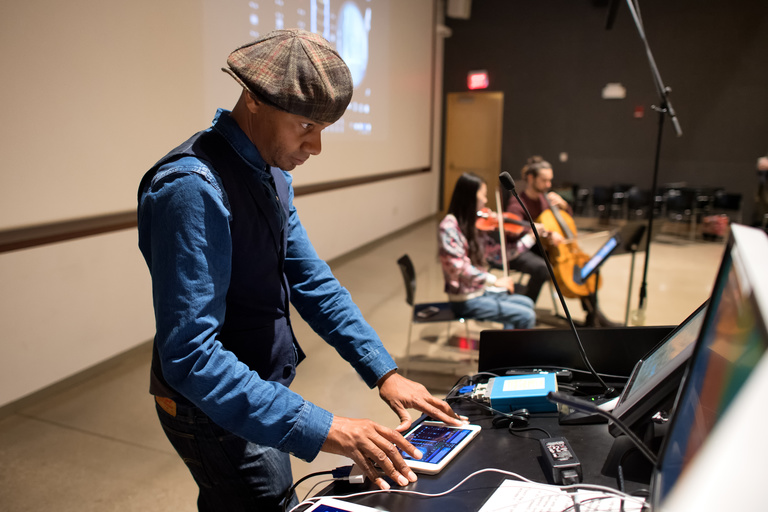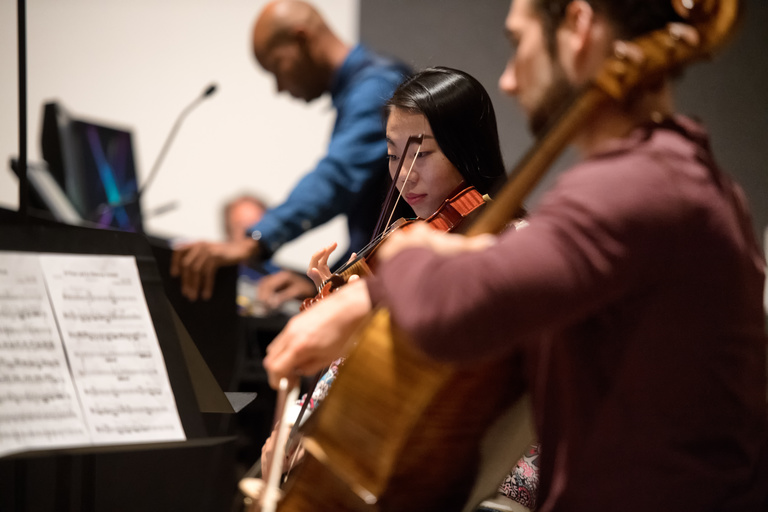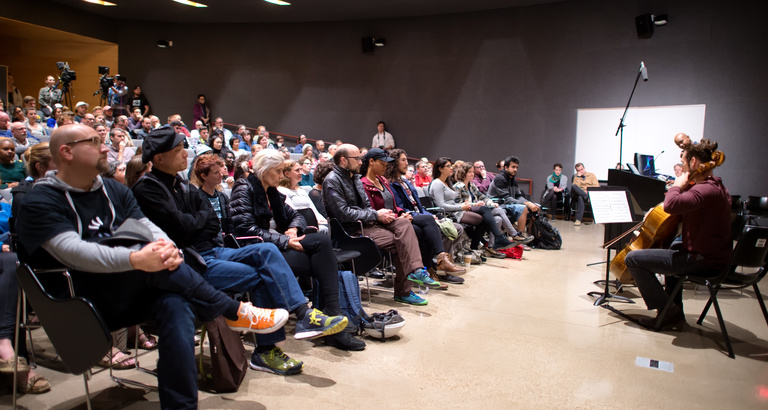
Miller’s lecture previewed the first movement of his original electronic score – EXPLORER I: REMIX – which the University of Iowa Libraries commissioned to honor the 60th anniversary of the historic satellite launched in 1958 and containing an instrument built at the UI and used to discover Earth’s radiation belts. As Miller discussed his creative process, it became clear that he takes the acoustic principles that govern how a disc-jockey mixes sound and expands them to the visual arts, science and history.
Drawing the threads of culture, innovation, and ideas throughout time – from Thomas More to America’s manifest destiny to Sputnik and the late UI physicist James Van Allen’s Geiger–Müller tube instruments aboard the Explorer I satellite – Miller selects or “samples” this tapestry of events and ideas. This sampling is then reinterpreted as a mashup of newly composed melodies, audio and video recordings and beats mixed into a fresh, original work.
Confused? Let’s back up.
Sampling, said Miller, is taking pieces of your influences and creating something new. “Sampling is about impermanence,” he said. “It’s about the illusive notion that no one version is correct. You can always just open a file up and change it.” Miller demonstrated this philosophy most vividly in 2004 when he remixed the controversial 1915 film “Birth of a Nation” into “Rebirth of a Nation,” layering a new soundtrack and narration over the film.
There are ongoing legal and creative challenges around music sampling, an issue Miller briefly highlighted by showing a short clip of the 2009 documentary "Copyright Criminals," directed by University of Iowa professor Kembrew McLeod and UI alumnus Benjamin Franzen.
Given the restrictions on using copyright materials, Miller has instead pursued the intersection of his art and science. By “sampling the sound of science,” he works primarily with open-source materials such as numeric scientific data, which he puts through a process called “arrhythmic music transcription,” which can then be looped and layered into original work.
To demonstrate, Miller performed a live remix of his work Of Water and Ice. For this work, Miller said, he sampled Kepler’s 17th century essay on snowflakes, 1960s author Iceberg Slim, and time spent in Antarctica borrowing new mathematical scientific data from research scientists and recording the sounds of ice cracking.
“[N]o one owns the Earth,” said Miller. “So what I did was take data from the project and make an open-source album. Because there is no government in Antarctica, the whole relationship with copyright and ownership evolves to a much more open and sharing community, which is what science is supposed to be about. The open movement of information between community cultures is what makes the world robust in relationship to history and our future.”

“The beautiful thing that we’re doing is we are seeing a collision between a traditional instruments and traditional notation and this idea of loops and layers and improved sampling and collage,” Miller said after the demonstration. “For me at least, this is about a conversation between instruments and how different tools evolve in a different era.”
For the EXPLORER I: REMIX, Miller said, he was struck by how Explorer I was the United States’ response to Sputnik. Sputnik was the first satellite to orbit Earth and launched the space race between the Soviet Union and the United States in 1957.
“There’s a geopolitics in space,” said Miller. “When you start thinking about satellites and geostellar phenomena, the first thing you have to remember is it comes from the heart of the Cold War. The first sound heard around the world was taken from Sputnik. It was the first sound literally going global.”
Miller drew lines to Explorer I from Thomas More’s Utopia which, he claimed, “…. revolutionized the American sense of how we thought about space and time. It was a document that formed the Constitution, and the way that American thinks about open space as a utopian vision of a city on a hill.”
Yet the act of going into space presented the world with an increasing body of information that the invisible impacts us more than what is visible.
“Human beings can only experience a small sliver of the universe,” said Miller. “Our eyes can only take in a limited spectrum of light; our ears only hear certain frequencies. With the Van Allen belts, we discovered there is a physical spectrum of material around us that is far more powerful than anything we’d ever encountered. And that’s what this next piece is about.”

In keeping with his commitment to open-sourcing, Miller is inviting the participation of UI students and faculty as the composition develops. Miller’s full EXPLORER I: REMIX score will be performed in spring 2017, incorporating newly restored and digitized audio and visual materials from the UI Library’s archival collection of instrumentation data from the historic mission, and will be accompanied by visuals created in collaboration with the UI Digital Scholarship & Publishing Studio.
“When you think about the geopolitics of space and the Cold War, we can think about the satellites and the competition between great powers set the tone for space,” said Miller. “Now it’s about thinking about better ways of exploring the planet around us with art.”
For a full listing of other events in the 2016-17 Creative Matters lecture series, please visit https://creativematters.research.uiowa.edu/.
The Creative Matters lecture series seeks to demonstrate that creativity is not only at the core of all research and discovery, but is also central to our human experience. The lineup of invited speakers includes artists, thinkers, builders, and doers who challenge conventional thinking about creativity, science, and artistic expression, borrowing from a range of influences and disciplines in their work.
The Office of the Vice President for Research and Economic Development provides resources and support to researchers and scholars at the University of Iowa and to businesses across Iowa with the goal of forging new frontiers of discovery and innovation and promoting a culture of creativity that benefits the campus, the state, and the world. More at http://research.uiowa.edu, and on Twitter: @DaretoDiscover.
Photos: (Top) Paul Miller (aka DJ Spooky) performs a live remix at Creative Matters lecture.
(Middle) UI School of Music graduate students Snow Zhang (violin) and Matt Laughlin (cello) perform wtih Paul Miller at Creative Matter lecture.
(Bottom) Paul Miller (aka DJ Spooky) performs for a full house at Creative Matters lecture.
Credit: Justin Torner/The University of Iowa, Strategic Communication